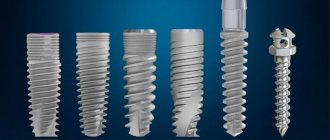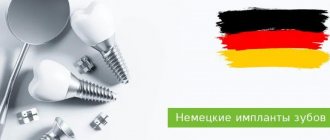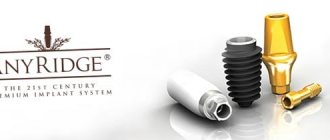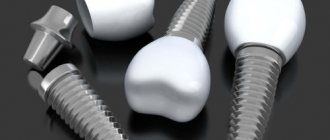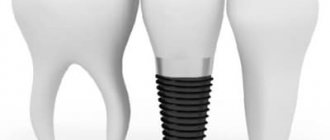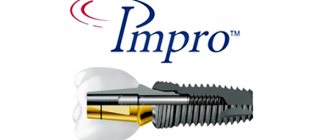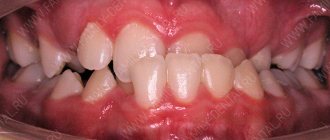By the level of engraftment By the time of osseointegration By the volume of bone tissue Possibilities of prosthetics Indications and contraindications Types of implants TOP brands
Dental implantation is rapidly gaining popularity. Every year, about a million patients improve their quality of life and the aesthetics of their smile thanks to implants. There are dozens of brands and models on the service market, and they all compete with each other. Each pin released falls into a certain, albeit unofficial, category and affects the popularity of the brand. Dentists say that the best dental implantation is the one that suits the given clinical case. Why then does one implant cost 15 thousand rubles, and the other 60 thousand?
The price of an implant is influenced by many factors, primarily the manufacturer. Famous brands invest millions of dollars in research, development and search for new technologies. The high quality of their products is guaranteed, because products from well-known brands meet all the key parameters required for implants.
Let's consider what criteria influence the rating of dental implants.
Bicon implant installation process (USA):
Stage 1. Preparation
At the initial consultation, the doctor examines and assesses the state of your oral health. The thickness and mobility of the mucous membrane, the condition of the jaws and bite are determined. Tests, radiography, and computed tomography are prescribed. Using tomography, a working model of the structure is developed, which is needed for the correct location of the system. Based on the results of the examination, a clinical picture and subsequent treatment plan are drawn up.
Professional cleaning is carried out - plaque and tartar are removed. If there is a disease, sanitation is carried out - caries and other inflammatory processes are eliminated.
Stage. 2 Implant installation
The installation process according to the protocol is similar to other implantation methods. The artificial root is implanted under local anesthesia. The clinic uses effective pain relief methods; the patient will experience virtually no discomfort. The surgeon performs an osteotomy, prepares a section of bone to prepare the bed, and creates a socket into which the implant is implanted. The wound is closed and stitches are applied. The fixation procedure takes on average 50–60 minutes. If necessary, a temporary crown is installed - this will allow the patient to achieve an aesthetic smile during the period of osseointegration.
Stage. 3 Prosthetics
Restoration on Baikon implants is carried out using a one-step, two-stage technique. After osseointegration of the artificial root (3-6 months), the abutment and crown are installed. The healing period depends on the surgical procedure and the anatomical features of the jaws.
Implantation can be performed immediately after tooth extraction, or in the case of severe bone tissue atrophy - after a few months.
The unique design of Bicon systems ensures successful regeneration of cortical bone at the neck of the product. This prevents the tissue from reabsorbing.
Osseointegration time
In order for a titanium post to perform all the functions of a natural tooth, it must be covered with bone tissue. This phenomenon is called osseointegration. Only after its completion the implant becomes stable and ready for prosthetics. In the classic protocol, implantation is carried out in 2 stages. 10-15 years ago between installation and prosthetics took from 6 to 9 months
. Modern design and coating of implants from leading companies have reduced this time to 2, maximum 3 months. So, which implants are best placed also depends on how long the patient is willing to wait for the completion of the osseointegration process.
Advantages of Bicon implants (USA):
- lack of threaded fasteners/elements;
- small product size;
- reliable fixation;
- lifetime quality guarantee;
- high survival rate (99%);
- ease of installation, installation without a crown is possible;
- the ability to perform express operations with instant loading;
- hermetically sealed connections to prevent the formation of cavities.
The risk of rejection of an American implant tends to zero, since it is made of biocompatible materials. Beacon implants are a safe and painless restoration of teeth that work and look like natural ones.
The design has high aesthetic indicators. The patient will not encounter such a problem as a dark stripe on the neck of the tooth, which appears as a result of gum recession after prosthetic crowns.
Implants are a tightly connected structure. This structure ensures comfortable wearing and does not allow pathogenic organisms to develop at the site where the system is introduced.
The versatility and high level of stability allow the implants to be used even in difficult clinical situations. The shape of the artificial root is securely fixed in the socket, which in some cases does not require bone grafting.
Due to their biocompatibility, aesthetics and high durability, Bicon systems have gained popularity around the world.
American artificial roots Zimmer
Zimmer implants have been on the market for over 10 years. They are considered unique in their kind, having won the recognition and respect of patients and implantologists. The length of such implants ranges from 0.85 to 1.5 cm.
Features of American Zimmer implants:
- Implants are produced from a unique tantalum material, which is characterized by increased survival characteristics in the bone;
- Individual implant posts are made individually for each patient;
- A series of implantation systems called 3I, for example, has a patented Osseotite coating, which helps accelerate the growth of native tissue around the implant;
- An impeccable aesthetics of the final result is achieved.
Care
Implants require meticulous care
. You should regularly clean the denture with a soft brush, use rinses, dental floss, floss, undergo routine examinations, and follow all the dentist’s recommendations. Provided proper operation, the service life of the system is 15-20 years.
Implantologists at Dr. Razumenko’s clinic perform operations at the highest level, which reduces the risk of complications to a minimum. After surgery, the following are possible:
- pain, swelling in the implant area;
- minor bleeding;
- increase in body temperature.
If the patient follows all medical recommendations, the pain and discomfort goes away quickly enough. In the first days after implantation.
- If swelling occurs, ice should be applied to the implantation site.
- In the first week, do not resort to increased physical activity.
- Avoid intensive rinsing of the mouth, do not spit, and do not touch the implantation site with your tongue.
- In the first days, doctors recommend avoiding alcohol consumption and quitting smoking.
Advantages of the All-on-6 technique
Let's start the explanation with the disadvantages of all on 4 implantation.
What are shortened dentitions and when is “all-on-4” implantation optimal? There is also the “all on 4” technique
, when 4 implants are installed - two implants in the frontal section are installed perpendicular to the bone, and two implants - those installed in the lateral sections, they are installed at an angle of 45 degrees.
And the exit of the shaft of the implant that is installed at an angle often happens in the area of the second premolar, and in this case it is not always possible to achieve such a result.
Sometimes this exit occurs in the area of the first premolar and the patient’s dental rows are shortened - this is not always good.
If the patient is petite, the jaw is small
, then carrying out implantation with 4 more, I think, is acceptable.
What is good about the all-on-6 method?
If the jaw is quite massive, and since we need teeth not only to smile, but also to chew food, then, in my opinion, implantation solves this problem, when the minimum is 6 implants. There may be more:
- for example, 7
implants - as in this clinical case:
- eight
implants , as in this clinical case:
- or even ten implants
, as in this clinical case:
But 6 implants
— this is, as it were,
optimal minimalism
. And six implants are quite enough to make a reliable structure that will completely restore the entire dentition - this work will not be some kind of truncated work, like all-4 work, when the teeth end only with the frontal section and chewing teeth 6 and 7 -x often does not happen.
For normal occlusion, in order for the jaw to close correctly and well, normal contact in the chewing region of the upper and lower jaw is necessary. That is, we must have normal adequate occlusion so that our joint does not suffer, and our teeth close fully, and there is no closure only in the frontal region.
Prices for Bicon implants
Premium systems produced by the American company Bicon Dental Implants are distinguished by a reasonable price against the backdrop of excellent quality, durability and minimal risk of rejection. The final cost depends on the implant model, clinic equipment, and doctor’s qualifications. The average price tag in Moscow varies between 22-37 thousand rubles.
To find out the price of American titanium implants Bicon, sign up for a consultation at Dr. Razumenko’s dentistry by calling.
| Code no. | Name of procedures | Unit of measurement | Cost, rub. |
| 101 | Repeated treatment and diagnostic appointment of the patient | 650,00 | |
| 300 | Application anesthesia | 150,00 | |
| 301 | Infiltration anesthesia, conduction | 550,00 | |
| 653 | Installation of Bicon implant (USA) | 1 PC. | 50 000,00 |
* The prices indicated on the website are not a public offer. The exact cost of treatment can only be determined at an appointment with a doctor.
Prices for treatment in Moscow full price list
Share on social media networks:
Article Expert:
Lavrentyev Sergey Sergeevich
Doctor - dentist, surgeon, implantologist. He regularly improves his professional level and studies modern methods of dental implantation and surgical dentistry at international seminars and conferences of outstanding implant surgeons in the world.
Work experience 25 years
Service life of Nobel implants and manufacturer’s warranties
We already wrote above that the Nobel brand gives a lifetime guarantee for its product. What does this mean? The fact that Nobel implants, with proper care of your teeth and oral cavity, can last you a lifetime and even if something happens to the crown placed on the implant, the artificial root itself will not have to be changed.
If suddenly, for some reason, Nobel implants are rejected after surgery, then replacement and payment of treatment costs is carried out at the expense of the manufacturer. Let us clarify that the reasons for rejection of the Nobel implant in order to replace it under warranty should not be associated with either the patient’s negligent attitude towards his health or the incompetence of the doctor. In the latter case, all costs for re-treatment to replace the Nobel implant are borne by the clinic where the unsuccessful operation was performed.
USEFUL TO KNOW: Implant rejection is a fairly serious complication after dental implantation. The treatment will be long and unpleasant. To eliminate the risks of such consequences for yourself, always choose a clinic for your treatment wisely and carefully! Dentistry must be well equipped, and its specialists must be able to work with implantation systems of a specific brand - Nobel or any other. This skill must be confirmed by appropriate licenses, certificates and diplomas!
Nobel provides a guarantee not only for implants, but also for their abutments. The warranty period for Nobel abutments is 10-12 years.
We recommend that you read
Inno implants (South Korea)
Impro implants (Germany)
Dental implantation
Basal implantation
Age of patients for the All-on-6 technique
For “all on 6” implantation, this is, of course, the older age group. Mostly people over 45 years of age come to us. When there is talk about implantation “all on 6” - there is practically no upper limit.
Here is an example of total prosthetics for a 70-year-old patient whose initial situation was as follows:
And the result of his prosthetics is presented in the following picture:
The oldest patient we did this kind of work on was 87 years old, and everything went very well, thank God, both for the patient and for us. Well, in principle, this technique can be used even from the age of 20, if there is a need for it, but often in patients at the age of 20, all teeth are present and everything should be fine.
Recommendations after All-on-6 implantation
After installing the structure on “all-on-6” implants, the patient is usually recommended the same recommendations that we give after any implantation - it is necessary to take either 5 or 7 days of antibiotics, baths with an antiseptic, when the patient holds an antiseptic in his mouth to muffle the flora.
Among the special recommendations is the recommendation not to eat hard or viscous foods. Well, of course, immediately after implantation you should not overload them, try to chew the steak and overload them. Everything should be soft and easy to chew so as not to overload the implants that are installed in the patient.
Are there permanent restrictions after All-on-6 implantation?
There are no restrictions as such. The patient is only not recommended to do what is not recommended to do with his teeth - try to crack nuts, rip off the insulation from wires, although patients “sin” in that due to the fact that the implants are tightly fixed into the bone, they do not have the same teeth as teeth. , no periodontal ligament. And when we create a load, we can develop a much greater force than with our teeth, and some patients forget when they have had these structures in place for a long time.
I had a patient who chewed an olive pit, although I don’t know how this could have occurred to him, but he did it, but he chipped the ceramic that was on the zirconium prosthesis and had to do a restoration.
Implantation
- Basal implantation
- Bloodless implantation
- Dental implantation
- Screw implants
Marinova Larisa Nikolaevna
Lavrentyev Sergey Sergeevich
+7, +7 (915) 1-999-111
All-on-6 for cancer and diabetes
Those patients who have some kind of malignant neoplasms and are undergoing treatment, if the patient is in remission and if this remission lasts more than 2 years and he tests tumor markers and everything is fine, then this patient can have implants installed, and we we install them.
Patients with diabetes are a fairly common disease now; we have many such patients.
Of course, we do not install implants as soon as the patient arrives and “everything is 6”, let us quickly install everything for you today - no, this is not our approach. The patient is interviewed, an anamnesis is collected, he is sent for tests, we look at sugar levels, what units, and communicate with the patient - this is type 1 diabetes, type 2 and we collect an anamnesis. And based on the anamnesis, we are already building a rehabilitation plan
:
How do you prepare for All-on-6 implantation?
Before starting the “all-on-6” operation, the patient sees an orthopedist. The orthopedist discusses in detail with the patient, finds out his wishes, assesses the situation, makes optical impressions, and sends him to CBCT in order to compare the optical impressions of the intraoral scanner and bone computed tomography.
And the complete rehabilitation is carried out first in digital form, when all the implants are placed in the right positions in the program, a surgical template is ordered, and we already know completely at the stage of the operation that everything has been predicted. We know in what place the implants will be installed, what diameter, what length, at what angle they will be installed, what orthopedic superstructure will be - this is necessary for fixing the prosthesis. That is, at the planning stages we do everything to eliminate force majeure during the operation and in order to get the result that we want to get - this is a good result.
What tests should be taken before All-on-6?
Before implantation of “all on 6”, we recommend that patients take a blood test, in which we will indicate both the patient’s sugar and hormonal parameters. And after this we can move on to further rehabilitation of the patient.
